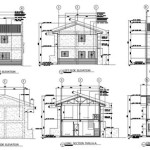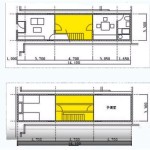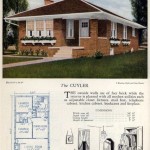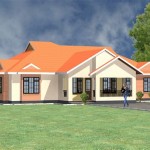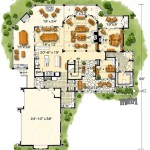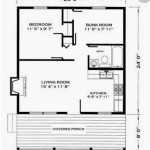Modern Greek House Plans: An Exploration of Design and Functionality
Modern Greek house plans represent a contemporary interpretation of classical architectural principles, blending the iconic elements of Greek design with the needs and preferences of 21st-century living. These plans often incorporate features such as clean lines, natural light, open spaces, and a strong connection to the outdoors, while simultaneously embracing modern materials and technologies to create comfortable, energy-efficient, and visually appealing homes. Understanding the nuances of these designs requires an examination of their historical roots, their core design principles, and the adaptations that make them suitable for modern lifestyles.
The allure of Greek architecture lies in its timeless elegance and enduring practicality. From the ancient temples and theaters to the whitewashed homes nestled on the islands, Greek design has always prioritized harmony, balance, and functionality. Modern Greek house plans seek to capture this essence, creating spaces that are both aesthetically pleasing and highly livable. The result is a unique architectural style that resonates with homeowners seeking a blend of tradition and modernity.
Key Aspects of Modern Greek House Plans
Several key aspects define modern Greek house plans, setting them apart from other architectural styles. These include an emphasis on natural light, the use of specific building materials, and the incorporation of outdoor living spaces.
Maximizing Natural Light
A hallmark of modern Greek house plans is the strategic use of natural light. Large windows, often oriented towards the south or west, are employed to capture sunlight throughout the day. Clerestory windows, positioned high on walls, can further enhance illumination, casting light deep into the interior spaces. The abundance of natural light not only brightens the home but also contributes to a sense of openness and airiness. Furthermore, natural light has been shown to have beneficial effects on mood and productivity, making it a desirable feature for modern homeowners.
The placement of windows is often carefully considered to maximize solar gain during the winter months and minimize it during the summer. Overhangs, awnings, and strategically planted trees can provide shade, preventing excessive heat buildup and reducing the need for air conditioning. This passive solar design strategy contributes to energy efficiency and reduces the environmental impact of the home.
In addition to windows, skylights and light wells can be incorporated to bring natural light into areas that might otherwise be dark, such as hallways or bathrooms. The use of light-colored interior finishes, such as white or pastel walls, further enhances the effect of natural light, reflecting it throughout the space and creating a bright and inviting atmosphere.
Materials and Finishes
The choice of materials in modern Greek house plans is often influenced by the availability of local resources and a desire to create a connection to the surrounding environment. Traditionally, Greek architecture has relied on materials such as stone, stucco, and wood. Modern interpretations may incorporate these materials but often with a refined and contemporary twist.
Whitewashed stucco remains a popular choice for exterior walls, reflecting sunlight and providing a cool, durable surface. Natural stone, either in its raw form or as cladding, can be used to add texture and visual interest to the facade. Wood, often in the form of exposed beams or window frames, provides a warm and natural contrast to the white stucco and stone. The use of these materials contributes to the overall aesthetic of the home, creating a sense of authenticity and connection to the region.
Inside the home, materials like concrete, tile, and wood flooring are commonly used, offering durability, ease of maintenance, and a clean, modern look. The color palette typically leans towards neutral tones, such as white, beige, and gray, accented by pops of color inspired by the Mediterranean landscape, such as blues, greens, and yellows. These colors create a sense of calm and tranquility, reflecting the natural beauty of the Greek islands.
Modern Greek house plans also embrace the use of sustainable and eco-friendly materials whenever possible. This may include recycled content materials, low-VOC paints and finishes, and energy-efficient windows and doors. The integration of these materials reflects a growing awareness of environmental responsibility and a desire to create homes that are both beautiful and sustainable.
Outdoor Living Spaces
A crucial aspect of modern Greek house plans is the seamless integration of indoor and outdoor living spaces. The Mediterranean climate lends itself to outdoor living, and these plans often feature expansive patios, courtyards, and balconies that extend the living space beyond the walls of the home. These outdoor areas are designed to be comfortable, functional, and inviting, encouraging residents to spend time outdoors enjoying the sunshine and fresh air.
Patios and courtyards are often shaded by pergolas or covered walkways, providing protection from the sun and creating a comfortable space for dining, relaxing, or entertaining. Outdoor kitchens, complete with grills, sinks, and countertops, are becoming increasingly popular, allowing homeowners to prepare and enjoy meals al fresco. Swimming pools, hot tubs, and fire pits can further enhance the outdoor living experience, creating a luxurious and inviting retreat.
Landscaping plays a vital role in creating a cohesive and aesthetically pleasing outdoor space. Native plants, such as olive trees, lavender, and rosemary, are often used to create a Mediterranean-inspired garden that is both drought-tolerant and visually appealing. Stone pathways, gravel beds, and water features can further enhance the natural beauty of the landscape, creating a serene and inviting outdoor environment.
Adapting Greek Design for Modern Lifestyles
While modern Greek house plans draw inspiration from traditional Greek architecture, they also incorporate features that cater to the needs and preferences of modern lifestyles. This includes open floor plans, modern amenities, and energy-efficient technologies.
Open Floor Plans
One of the most significant departures from traditional Greek architecture is the adoption of open floor plans. In contrast to the compartmentalized rooms of older homes, modern Greek house plans often feature large, open spaces that combine the living room, dining room, and kitchen into one seamless area. This open layout promotes social interaction, creates a sense of spaciousness, and allows for greater flexibility in furniture arrangement.
The open floor plan is particularly well-suited to contemporary lifestyles, where families often spend time together in shared spaces. It also facilitates entertaining, allowing guests to move freely between different areas of the home. The kitchen, often positioned as the heart of the home, becomes a central gathering place for cooking, eating, and socializing.
While open floor plans offer numerous benefits, it is important to consider the potential for noise and lack of privacy. Strategic use of furniture, rugs, and screens can help to define different zones within the open space and create a sense of separation. Soundproofing materials can also be used to minimize noise transmission between areas.
Modern Amenities
Modern Greek house plans incorporate a range of modern amenities to enhance comfort, convenience, and functionality. This may include state-of-the-art kitchens with high-end appliances, luxurious bathrooms with spa-like features, and smart home technology that allows for remote control of lighting, heating, and security systems.
The kitchen is often designed as a focal point of the home, featuring custom cabinetry, granite or quartz countertops, and stainless steel appliances. Islands or peninsulas provide additional workspace and seating, while walk-in pantries offer ample storage for food and supplies. The use of energy-efficient appliances and lighting further contributes to the sustainability of the home.
Bathrooms are often designed as tranquil retreats, featuring soaking tubs, walk-in showers, and double vanities. High-end fixtures, such as rain showerheads and heated towel racks, add to the luxurious feel. The use of natural stone or tile, combined with soft lighting, creates a relaxing and inviting atmosphere.
Energy Efficiency
Energy efficiency is a key consideration in modern Greek house plans. These plans often incorporate features such as high-performance windows and doors, insulation, and energy-efficient heating and cooling systems. Solar panels and other renewable energy sources may also be integrated to reduce the home's carbon footprint.
Passive solar design principles are often employed to maximize solar gain during the winter months and minimize it during the summer. This can include orienting the home to take advantage of sunlight, using overhangs to provide shade, and planting trees to block unwanted solar radiation. The use of light-colored exterior finishes further helps to reflect sunlight and reduce heat buildup.
High-efficiency HVAC systems, such as heat pumps and geothermal systems, can significantly reduce energy consumption for heating and cooling. Smart thermostats allow for precise control of temperature settings, optimizing energy use and reducing utility bills. The use of LED lighting throughout the home further contributes to energy savings.

Delta House Mastering Geometric Intrigue In Modern Greek Architecture Homeadore

Modern Villa 191 In Voula Greece By Isv Architects Single Y House Plans Plan How To

Houses In Greece Archdaily

Exterior Modern Greece Home Interior Design Ideas

A Small But Beautiful Home On Antiparos Greece Style Files Com Mediterranean Homes Architecture

Four Breathtaking Greek Villas

Greek Houses Dezeen

Greek Houses A Collection Curated By Divisare

Greek Revival Home Plan 81037w Architectural Designs House Plans

A Stunning White Modern Home On Greek Island Design Lover House Architecture

